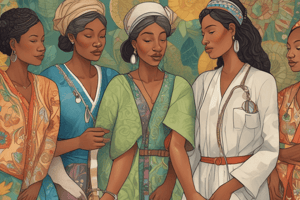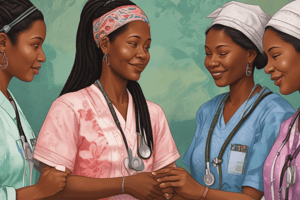Podcast
Questions and Answers
Which of the following actions best demonstrates a nurse's application of cultural humility in practice?
Which of the following actions best demonstrates a nurse's application of cultural humility in practice?
- Discouraging patients from using traditional healing methods.
- Assuming a patient's healthcare needs based on their ethnicity.
- Providing standardized care plans to patients from diverse backgrounds.
- Acknowledging one's own cultural biases and seeking to understand the patient's perspective. (correct)
How does a nurse's understanding of 'etic' knowledge enhance cultural competence?
How does a nurse's understanding of 'etic' knowledge enhance cultural competence?
- By dismissing the importance of cultural norms in healthcare.
- By providing an insider's perspective on the patient's cultural beliefs.
- By offering an outsider's, or objective, viewpoint on cultural practices. (correct)
- By reinforcing stereotypes to streamline care delivery.
A healthcare organization aims to improve its organizational health literacy. Which action would be most effective?
A healthcare organization aims to improve its organizational health literacy. Which action would be most effective?
- Expecting patients to navigate the healthcare system independently.
- Using medical jargon to maintain professional standards.
- Ensuring healthcare information is accessible, understandable, and supports informed decision-making. (correct)
- Providing complex medical information to patients.
A nurse is caring for a patient who speaks a different language. What is the most appropriate action to ensure effective communication?
A nurse is caring for a patient who speaks a different language. What is the most appropriate action to ensure effective communication?
What is the primary goal of integrating cultural competence into nursing practice?
What is the primary goal of integrating cultural competence into nursing practice?
Which strategy would be most effective in helping to eliminate health disparities?
Which strategy would be most effective in helping to eliminate health disparities?
A nurse notes that a particular cultural group has a higher rate of diabetes compared to the general population. Which action demonstrates cultural competence in addressing this disparity?
A nurse notes that a particular cultural group has a higher rate of diabetes compared to the general population. Which action demonstrates cultural competence in addressing this disparity?
What is the significance of the American Nurses Association (ANA) Standard 9: Respectful and Equitable Practice?
What is the significance of the American Nurses Association (ANA) Standard 9: Respectful and Equitable Practice?
Which of the following is the best example of a nurse advocating for health equity?
Which of the following is the best example of a nurse advocating for health equity?
A hospital implements a policy that all patient education materials must be available in multiple languages and at various literacy levels. What is the primary goal of this policy?
A hospital implements a policy that all patient education materials must be available in multiple languages and at various literacy levels. What is the primary goal of this policy?
What is the purpose of conducting a self-assessment for implicit biases in nursing practice?
What is the purpose of conducting a self-assessment for implicit biases in nursing practice?
Leininger's Theory of Culture Care Diversity and Universality emphasizes that nurses must:
Leininger's Theory of Culture Care Diversity and Universality emphasizes that nurses must:
Which of the following best describes 'health equity'?
Which of the following best describes 'health equity'?
A nurse uses the ISBARR (Identify, Situation, Background, Assessment, Recommendation, and Response) communication tool when communicating with a provider about a patient. How does this improve culturally competent care?
A nurse uses the ISBARR (Identify, Situation, Background, Assessment, Recommendation, and Response) communication tool when communicating with a provider about a patient. How does this improve culturally competent care?
Which factor primarily contributes to health disparities among vulnerable populations?
Which factor primarily contributes to health disparities among vulnerable populations?
A clinic primarily serves recent immigrants. To improve health literacy, which of the following steps would be most helpful?
A clinic primarily serves recent immigrants. To improve health literacy, which of the following steps would be most helpful?
What is the primary aim of Leininger's Sunrise Enabler model in nursing?
What is the primary aim of Leininger's Sunrise Enabler model in nursing?
Which action demonstrates effective culture care accommodation or negotiation?
Which action demonstrates effective culture care accommodation or negotiation?
According to the CDC, what is intersectionality as it relates to vulnerable populations?
According to the CDC, what is intersectionality as it relates to vulnerable populations?
Flashcards
Holistic Approach in Nursing
Holistic Approach in Nursing
Nursing care that considers the diverse backgrounds of patients.
Culturally Competent Care
Culturally Competent Care
Ensures safe, respectful, and ethical nursing practices while reducing health disparities.
Theory of Culture Care Diversity and Universality
Theory of Culture Care Diversity and Universality
Nurses must understand and incorporate cultural beliefs, values, and practices into patient care.
Cultural Awareness
Cultural Awareness
Signup and view all the flashcards
Implicit Bias
Implicit Bias
Signup and view all the flashcards
Explicit Bias
Explicit Bias
Signup and view all the flashcards
Cultural Diversity
Cultural Diversity
Signup and view all the flashcards
Cultural Competence
Cultural Competence
Signup and view all the flashcards
Emic Knowledge
Emic Knowledge
Signup and view all the flashcards
Etic Knowledge
Etic Knowledge
Signup and view all the flashcards
Health Equity
Health Equity
Signup and view all the flashcards
Health Equality
Health Equality
Signup and view all the flashcards
Personal Health Literacy
Personal Health Literacy
Signup and view all the flashcards
Organizational Health Literacy
Organizational Health Literacy
Signup and view all the flashcards
Vulnerable Populations
Vulnerable Populations
Signup and view all the flashcards
Health Disparities
Health Disparities
Signup and view all the flashcards
Culturally Competent Care: Preservation & Maintenance
Culturally Competent Care: Preservation & Maintenance
Signup and view all the flashcards
Culturally Competent Care: Accommodation & Negotiation
Culturally Competent Care: Accommodation & Negotiation
Signup and view all the flashcards
Culturally Competent Care: Repatterning & Restructuring
Culturally Competent Care: Repatterning & Restructuring
Signup and view all the flashcards
Leininger's Sunrise Enabler
Leininger's Sunrise Enabler
Signup and view all the flashcards
Study Notes
- Nursing care requires a holistic approach, considering the diverse backgrounds of patients.
- Culturally competent care ensures safe, respectful, and ethical nursing practices.
- Culturally competent care reduces health disparities and improves patient outcomes.
- Madeline Leininger developed the Theory of Culture Care Diversity and Universality.
- Theory emphasizes nurses who understand and incorporate cultural beliefs, values, and practices into patient care.
- American Nurses Association (ANA) Standard 9 highlights the importance of cultural humility and social equity in nursing.
Cultural Awareness
- Cultural awareness involves understanding and recognizing cultural differences in values, beliefs, and traditions.
Implicit Bias vs. Explicit Bias
- Implicit bias includes unconscious attitudes affecting patient interactions.
- Implicit bias examples involve gender or racial bias.
- Explicit bias refers to conscious beliefs that may lead to discrimination.
- Biases can lead to inadequate assessments and disparities in treatment.
- Nurses must conduct self-assessments to minimize bias and improve care.
- Cultural diversity includes differences in age, gender, ethnicity, socioeconomic status, religion, disability, and sexual identity.
Influence of Culture on Health Care
- Culture affects health beliefs, decision-making, and treatment acceptance.
- Nurses must adapt communication and care to meet patients' cultural needs.
Cultural Competence
- Cultural competence involves the ability to respect, understand, and respond to diverse patient needs.
Key Elements of Cultural Competence
- Emic Knowledge: Insider's cultural perspective.
- Etic Knowledge: Outsider's viewpoint on culture.
- Purnell Model and Leininger's Sunrise Enabler consist of tools to assess cultural needs.
Nursing Actions for Cultural Competence
- Use open-ended questions about cultural preferences.
- Avoid assumptions based on stereotypes.
- Provide language-appropriate resources.
- Utilize certified interpreters, not family members.
Health Disparities
- Health disparities are unequal health outcomes among different populations due to social, economic, and environmental barriers.
Examples of Health Disparities
- African American women have higher obesity rates.
- Hispanic population has higher rates of being underinsured.
- Asian Americans have a higher risk of chronic hepatitis B.
Factors Contributing to Health Disparities
- Limited access to healthcare includes lack of transportation and insurance.
- Socioeconomic status (low income) affects health choices.
- Discrimination and bias affect the quality of care.
- Language barriers decrease understanding of treatment options.
Health Equity, Equality, and Literacy
- Health equity ensures fair access to healthcare for all individuals.
- Health equality ensures everyone receives the same resources.
- Health equality may not address individual needs.
Health Literacy
- Personal Health Literacy: A patient's ability to understand health information.
- Organizational Health Literacy: Healthcare providers ensure information is accessible and understandable.
Strategies to Improve Health Literacy
- Use plain language in patient education.
- Provide visual aids and interpreters.
- Support community-based health education programs.
Caring for Vulnerable Populations
- Vulnerable populations are groups at higher risk for poor health outcomes due to limited access to resources.
- Older adults, immigrants, low-income individuals and LGBTQ+ individuals.
Examples of Vulnerable Populations
- Older adults: Increased physical disabilities and chronic conditions.
- Immigrants: Language barriers and lack of health insurance.
- Low-income individuals: Struggles with affording medication and healthcare.
- LGBTQ+ individuals: Higher mental health risks due to stigma and discrimination.
Demographics, Health Status, and Socioeconomic Factors
Demographics
- Age, language, race, and ethnicity affect access to preventive care.
Health Status
- Chronic conditions and disabilities limit ability to seek consistent treatment.
Socioeconomics
- Income, education and employment determine health literacy and affordability.
Addressing Health Disparities as a Nurse
- Assess Cultural Needs: Ask about dietary restrictions, religious beliefs, and traditional healing practices; incorporate culturally appropriate interventions.
- Advocate for Equitable Care: Help patients navigate the healthcare system; work with community programs to improve access.
- Improve Communication: Use ISBARR for clear communication; utilize certified interpreters.
Leininger's Sunrise Enabler Model
- Cultural and Social Structure Dimensions influence one's view of health and illness.
- Factors Affecting Health include technology, religion, social structure, economy, and education.
- Central Core Influences involve beliefs about illness, treatment, and healing.
- Healthcare Practices cover folk (traditional) care vs. modern medical care.
- Three Modes of Culturally Competent Care: Preservation & Maintenance, Accommodation & Negotiation, and Repatterning & Restructuring.
- Preservation & Maintenance supports patients in keeping cultural traditions.
- Accommodation & Negotiation modifies care to align with cultural beliefs.
- Repatterning & Restructuring encourages new practices for better health outcomes.
Practical Applications for Nurses
- Certified medical interpreters should be used to prevent miscommunication.
- Do NOT use family members due to potential inaccuracies.
- Provide written materials in the patient's primary language.
- Conduct self-assessments to identify implicit biases.
- Participate in diversity and inclusion training.
- Approach all patients with cultural humility.
- Help bridge gaps in care for vulnerable groups.
- Educate patients on available resources (financial aid, transportation).
- Support policies that promote health equity.
Studying That Suits You
Use AI to generate personalized quizzes and flashcards to suit your learning preferences.




